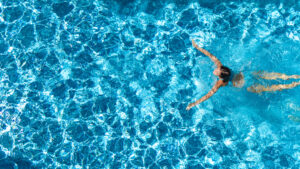Swimming and Yeast Infections
 Swimming is a wonderful way to exercise, relieve stress, practice less strenuous physical therapy, and many other benefits. Especially in the summer, we use swimming not only as a way to cool down, but also as the primary relaxation technique. After all, what is summertime without imagining ourselves by a pool or by the ocean?
Swimming is a wonderful way to exercise, relieve stress, practice less strenuous physical therapy, and many other benefits. Especially in the summer, we use swimming not only as a way to cool down, but also as the primary relaxation technique. After all, what is summertime without imagining ourselves by a pool or by the ocean?
We are already deep into the summer season, so our bodies have most likely been deep into pools, fresh water, or the sea. Along with the many positive effects that swimming can have on our physical and mental health, there are some elements that pose a threat to female hygiene and vaginal health: the widely dreaded yeast infections.
How are they caused?
Yeast infections are, essentially, fungal infections that cause irritation and discharge, as well as extreme itchiness. They thrive in conditions that help fungi develop: water with bacteria, or water with chemicals, as well as lounging in our swimsuits after swimming—innocently drying off in the sun while giving bacteria ample space to thrive.
How do we prevent them?
Currently over 138 million women suffer from recurrent candid, another name for yeast infections, so sound advice and safe habits can go a long way in preventing swim-induced infections.
- Immediately rinse off in a shower after swimming and change into dry swimsuit bottoms or fresh underwear. This drastically reduces the risk of bacterial development.
- Wash your swimwear when you get home. Use dye-free or sensitive laundry detergent, or if unavailable, rinse thoroughly with fresh water for several minutes. Hang your swimsuit up to dry completely before using it again.
- Reduce or eliminate your exposure to chlorinated water, especially in a hot water environment like a hot tub. This is a more drastic measure meant for those of us who are very prone to UTIs and candida, are pregnant, on antibiotic or certain medications, have diabetes, or a weakened immune system that may lead to yeast infections developing more easily.
- Keep your body hydrated with clean drinking water to assist your bladder in flushing out the bad bacteria and keeping the good bacteria. Remember that the female vagina is almost like a self-cleaning oven, and you can assist it in keeping itself healthy. Eating probiotic foods or taking liquid probiotic supplements, as well as reducing our intake of alcohol and sugary foods can also fortify vaginal pH balance.
What are some symptoms?
- If you experience increased frequent need to urinate, painful urination, chills, burning urination or even lower back aches, you may have developed a urinary tract infection as well.
- Increased discharge that potentially smells stronger and is gray colored, along with vaginal itching, tenderness and/or swelling are all signs of yeast infections.
As always, pay attention to what your body is feeling and doing. If something doesn’t feel, look or act normal down there, contact your gynecologist or general practitioner immediately. Yeast infections and UTIs are nothing to be embarrassed about, and important to address quickly for physical and mental wellness.
